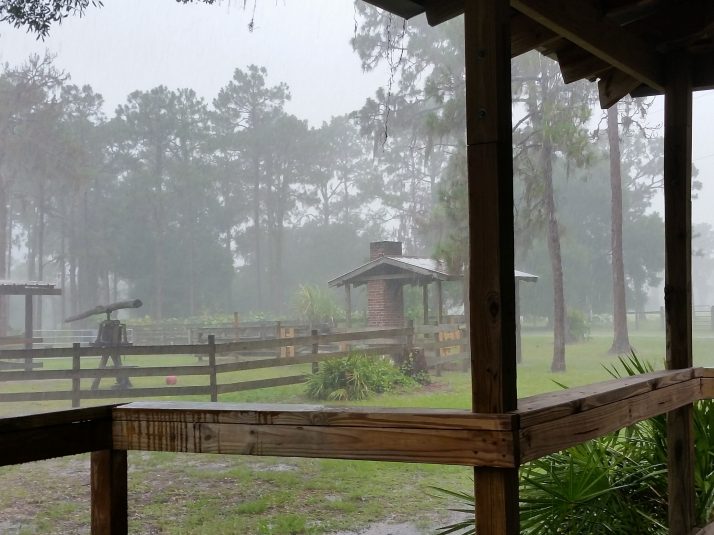Teaching in the Rain - No Problem
I came across this article recently and after having to cancel a rather large event this past weekend due to rain thought that now would be a good time to share. This article is written by Ray Cramer who is an experienced outdoor educator at IslandWood, a 225-acre outdoor leaning center in Bainbridge, WA Where they see their fair share of rain! So, for all of my friends in Florida (where we also get a fair amount of rain) I hope that you learn some useful tips on teaching in the rain.
Teaching In the Rain? No problem!
I teach outdoors on an island near Seattle, so I decided to recount a few things I have learned about teaching out in the rain over the years. Much like sitting outside in a circle, minding the details makes all the difference, so here are ten I keep in mind.
Zip-lock baggies
Writing in the rain is challenging, but usually worth the effort. One great technique is to put the journal or paper into a gallon zip closure bag. When the time comes to write, the writer turns the bag upside down and then unzips it while keeping the paper inside. They hold the paper in place through the bag with one hand and snake the other hand in to write, looking through the bag and being sure to keep the opening at the bottom. Short pencils work best with this approach (think golf pencils).
Raingear
Let’s start with the obvious—you should have waterproof raingear. For some, this means a Patagonia jacket, but I know a lot of outdoor educators, myself included, who have a $30 plastic jacket because you never have to worry about the seams. For everyone else, don’t let anyone kid you that their coat is waterproof when you can tell it isn’t. The bottom line is to make sure you have a truly waterproof rain jacket and pants for everyone.
Sit-upons
If it is not currently raining, help folks stay dry when they sit on something wet by having them fold their rain jacket or pants into a pad. Make sure they put the outside of the garment on the wet object, keeping the inside dry for wearing later. If they just have a rain jacket and are wearing it, they can usually pull it down as far as possible over their gluteus maximus and then sit on it. Of course, they could also just put those rain pants on.
R-e-l-a-x
Remind yourself that it is just rain. Relax your shoulders and turn your face into it. Enjoy a natural phenomenon and be in harmony with it. You will get no wetter. (Credit for this idea to Tom Robbins in Still Life With A Woodpecker)
Teach about the rain
Let the lessons come to you when it is raining. Animal tracking, watershed studies, erosion, water cycle, deposition, and amphibians all become even more authentic topics in the rain. Branching out from the natural world, building shelters, dams and boats can make science and engineering come to life as well. Even the act of gearing up could become a lesson on surface area, heat loss and physiology. Turn your lesson to the rain as well as your face!
Batten down
Recognize right away when it starts raining and stop for a moment to allow everyone to pull up their hood and zip their zipper. Don’t wait to see if it will get worse--it just did! You are either getting your base layers wet or you are not, so choose not. Many folks think their raingear leaks when it really is just operator error!
Use the drip line
Trees stay dry underneath to varying degrees. Know the species in your area and head to the best ones for an instant shelter. Even if you don’t know the trees where you are, one good indicator is dry ground or a dry trunk on one side. My favorite is currently Western red cedar, what is yours?
Heads lose 45% of your heat…
…so claimed a U.S. Army field manual from the 50’s, and the lore took off from there. While more recent studies put this at actually 7 to 10 percent (close to the head’s 9% of total body surface area), it is worthwhile to note that the head is usually the least clothed part of the body. Comfort equals focus, so get a warm hat on and perhaps some gloves too.
Backpacks
Make sure the backpack contents stay dry by lining them with a trash bag, splurging for a $5 pack cover, or simplest of all, putting the backpack on first and then the rain jacket over it and the person. Also be vigilant for an “inside job,” where the water bottle leaks onto everything. Prevent this by testing it--inverting the bottle and squeezing before considering putting it inside the pack. Planning ahead for your backpack as well as your body doubles your dryness.
Tarps
They are lightweight and cheaper all the time, so bring one along on the rainy days and take a few moments to be out of the precipitation at lunch or for a longer lesson. As a bonus, you have something to play games with, a hypothermia wrap, and a picnic blanket when the rain stops. What other tips do you have for teaching in the rain?


